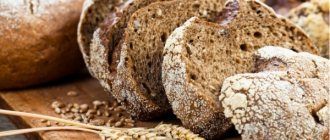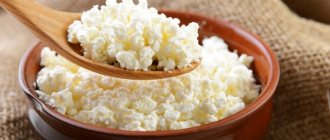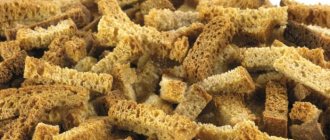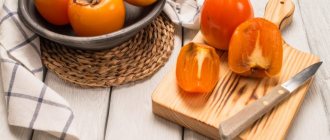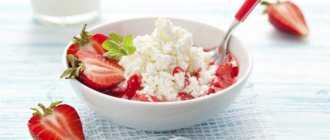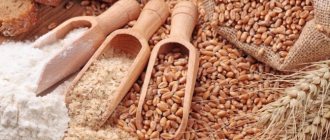Product benefits
Today everyone knows about the dangers of bread, but not many know about the benefits:
- Bread products are rich in fiber, which improves the proper functioning of the digestive tract.
- Thanks to the carbohydrates contained in bread, the human body receives energy.
- The products are rich in vitamin B, which calms the nervous system.
- The product contains protein and amino acids that help keep muscles and body toned.
Bread for gastrointestinal diseases
There are certain dietary rules for treating or preventing the disease. For example, during an exacerbation of gastritis, eating flour products is strictly prohibited. In the first days, they adhere to a strict diet, and liquid food is gradually introduced. Only then, after the condition has normalized, can you eat flour products, but in small quantities.
Gastroenterologists identify ingredients that should not be present in proper flour products:
- starch;
- margarine;
- leavening agents;
- dyes;
- preservatives;
- sugar;
- vegetable fat.
Bread alternative
Rusks become a favorable option for a patient suffering from pancreatitis. You need to be careful when choosing the type of bread. Rye crackers, for example, will cause a negative reaction in the pancreas. The amount of starch in breadcrumbs decreases along with the evaporation of water during drying; by consuming pieces of this bread, enzymes will not be formed, and digestion will be easy. The safest for the disease are crackers made from gray bread. If desired, you can make crackers from biscuit.
If crackers are made at home, careful attention is paid to choosing the right bread. The product should not contain chemical additives, spices, herbs, even natural ones. Vegetable fats are also not good for the body, eliminate them. After selecting the permitted product, the bread is cut into thin slices. Dry thoroughly so as not to injure the stomach or provoke inflammation of the gland. Crackers should be eaten in small quantities with kefir, herbal tea or liquid dishes.
Ready-made crackers from the store will need to be carefully checked. The product must be free of spices, preservatives, dyes, stabilizers and flavor enhancers. The listed additives will negatively affect human health. Attention must be paid to the integrity of the product packaging. If the package is damaged, patients are not allowed to eat the product.
The main advantage of crackers is considered to be easy digestion, without overloading the body with excess calories and causing a negative reaction in the pancreas. After fasting, small portions of crackers will be beneficial because they contain vitamins, fiber and microelements.
Bread
For those suffering from inflammation of the pancreas, bread can be used to replace bread. Most often sold in the diet food department. Special breads for the sick are offered for sale. Crispbread for pancreatitis will not cause irritation, keeping the pancreas calm, and does not contain flavorings, flavor enhancers, or dyes.
In case of exacerbation of the disease, dietary crackers are perfect as a replacement for other bakery products. Typically, breads contain flour from various grains, hence many beneficial properties. For patients with advanced diabetes mellitus, buckwheat flour breads are suitable. And for those suffering from diarrhea, rice flour breads are an ideal option. The products replace the daily dose of bread without losing the benefits for the body and taste.
Recommendations for choosing bread
When choosing a type of bread for gastritis, you must take into account the characteristics of the disease.
Dietary recommendations for people suffering from gastritis with high acidity are different and are not relevant for those who, on the contrary, have low stomach acidity.
Tips for excess stomach acid
In case of increased acidity, black bread is contraindicated. Its ingredients provoke excessive release of hydrochloric acid and, as a result, damage to the mucous membrane. This variety is difficult to digest and puts a strain on the digestive tract.
From the product appear:
Therefore, eating black bread for gastritis is not recommended.
Bread for lack of gastric juice
For patients suffering from gastritis with reduced secretion of hydrochloric acid in the acute stage, doctors advise excluding baked goods from the menu. They contain a large amount of carbohydrates, and their dietary fiber injures the inflamed walls of the gastric tract.
Due to digestive disorders, stagnation occurs in the stomach, and the system cannot function normally. Only when the condition has stabilized can you eat a couple of pieces of grade II wheat bread. If the tendency to diarrhea persists, stale white bread and crackers made from it are indicated.
For this category of patients, products with bran are also prohibited. A weak stomach cannot cope with the digestion of coarse fiber, and bran irritates the mucous membrane even more, and the risk of developing peptic ulcers increases.
Types of healthy bread
From all the variety on the shelves of the bread department, you can choose the truly right product that will not harm your sore stomach.
To do this, firstly, you need to adhere to the doctor’s recommendations, and secondly, do not forget about the basic properties of different types of product.
Product made from premium flour
Wheat flour of this type is not beneficial for the body, because it is refined - purified of all valuable nutrients. Products made from such flour are undesirable even for a healthy person. It is believed that the most useful are bakery products made from first and second grade flour.
For patients with gastritis of any form, the following are contraindicated:
- fresh bread;
- freshly prepared baked goods;
- sweet buns.
They contain yeast. When they enter the acidic environment of the stomach, they continue to ferment, causing indigestion and causing discomfort in the intestines. And as a result, bloating, dull pain, flatulence and poor health.
Proper bread
- White bread for gastritis is considered safe, but not rich or fresh, but yeast-free. This product is baked from first grade flour.
- Barley product is recommended for gastritis because it is easily digested by the stomach, does not cause stagnation and does not damage the mucous membrane.
- During remission of a chronic gastric disease, it is allowed to eat gray bread made from rye flour. The product improves the functioning of the digestive system and contains many nutrients.
- Rye bread for gastritis can be consumed, but no more than 2 pieces per day. In the acute stage, it is prohibited to eat it.
Crackers
Fresh bread has a high acid content, while bread crumbs contain practically no acids. Gastroenterologists recommend crackers even for gastritis with high acidity.
Bread for pancreatitis
Bread is considered a source of energy, proteins, carbohydrates, vitamins and mineral compounds. These necessary substances, of course, are useful for the speedy recovery of an organism weakened by the disease. Therefore, bread for pancreatitis is an important item in the diet.
- Vitamins in bread: A, choline, B1, B2, B6, B9, H, E, PP, beta-carotene.
- Minerals in bread: Molybdenum, potassium, manganese, phosphorus, iron, copper, calcium, iodine, selenium, zinc, chromium, sulfur, sodium, cobalt, chlorine.
On store shelves there is a huge variety of bakery products for every taste. What’s not there: various types of black, wheat bread with the addition of whole grains, bran, buns, crispbread...
Let's figure out how not to buy the “wrong” product, but choose the real “correct” bread, approved by experts for pancreatitis, and also consider which products you should abstain from.
It is not recommended to eat freshly baked bread if you have inflammation of the pancreas due to the fact that it contains a large amount of starchy compounds and yeast, which in turn cause fermentation in the stomach and can lead to discomfort in the intestines. Dried bread has a positive effect on digestion during pancreatitis. It contains vitamin and mineral compounds that help to quickly absorb food and satiate the entire body.
Wheat bread
It is advisable to exclude white bread made from premium or first-grade flour for pancreatitis.
The lower grade flour used for baking, the better and healthier it is, because such bread contains more minerals.
For these purposes, wallpaper flour or second-grade flour is used.
But even such bread needs to be dried before use.
You can make crackers out of it in the oven, drying the slices at low temperatures for about an hour, or simply dry it by spreading it out in the open. The norm of bread per day is 200 grams.
Important! You should not eat baked goods made from wheat flour at any stage of the disease!
Armenian lavash
Armenian lavash is a white bread, so you can eat it if you have pancreatitis, but do it with caution, observing your body’s reaction. Ideally, it should be baked a couple of days before eating and dried. You are allowed to eat no more than 200 grams of pita bread per day, divided into several meals. During remission, you can increase the daily intake to 300 grams.
Black (rye bread)
Having compared the composition of wheat and rye bread, we note that wheat contains 3 times more fats and carbohydrates, and 10% more starch.
But despite all this, you should not eat black bread in the acute period of pancreatitis, since it tends to increase acidity, and the proteolytic enzymes included in its composition can cause discomfort in the stomach.
Therefore, rye bread can be introduced into the diet only after the severe exacerbation has subsided.
However, it should not contain the following additives: prunes, raisins, dried apricots, nuts. And you need to eat it the same way as white - not freshly baked, but yesterday's, dried.
“Doctor’s” bread, which is enriched with protein and bran, is especially useful.
Wholemeal bread
Bread made from whole grain flour has all the positive properties of rye, but does not provoke an increase in acidity, so it is preferable to eat it. But it may contain many unground grain particles, which can injure the stomach and cause pain.
Based on this, it should be administered no earlier than on the 8th day after fasting. The daily dose of 200 grams must be divided throughout the day.
Bran for pancreatitis
We have all heard about how healthy bran bread is. It contains additives that enrich it with an increased content of iodine and calcium.
It contains a lot of fiber, the use of which is often recommended for diseases of the digestive tract.
Despite this, the consumption of bran in acute pancreatitis should be limited for the reason that the bran present in such bread can increase contractions in the stomach and intestines, which is harmful to the weakened pancreas.
And coarse particles of bran can have an aggressive effect on the stomach wall and increase pain.
Thus, bran is contraindicated during exacerbation. During remission, you can eat them, but be careful.
Crispbread for pancreatitis
Now in supermarkets, most often on the diet food shelves, we can find a huge variety of breads made from flour from various grains, which makes them even healthier.
In addition, now on the shelves you can see bread made specifically for patients with pancreatitis.
These breads do not contain dyes or additives to add flavor, so these breads are useful for pancreatitis; they can replace the use of all other types of bread on the patient’s menu.
Rules for eating bread
For most people, food without bread is of no value; almost every meal they eat is accompanied by this fiber-rich product, which saturates the body due to the carbohydrates it contains. After consuming this product, a person’s mental activity improves, and his body gains the necessary strength for Active
For patients with gastritis, gastroenterologists strongly recommend giving up fresh bread. But dried or yesterday's can be eaten.
Gastritis can occur against a background of low or low acidity, it is important to know that:
- For patients with high acidity, there are no special restrictions on the use of dried bakery products, but Borodinsky bread cannot be eaten, since the ingredients included in it can cause increased release of hydrochloric acid, which will further aggravate the situation.
- For those suffering from gastritis with low acidity, it is better to completely avoid bread with bran. This flour product contains a lot of fiber, and it is poorly digested by a painful stomach, while the bread is not digested, but only creates an even greater burden on the gastrointestinal tract.
- For people suffering from both types of the disease, fresh bread and pastries, pies and buns are strictly prohibited. Such products are baked with a yeast base, which provokes discomfort and indigestion in the intestines. When interacting with gastric juice, yeast baked goods continue the fermentation process, which causes pain and bloating. All this only aggravates the course of the disease.
Crackers and crispbread are a healthy and tasty alternative to fresh bread; you don’t have to eat them all the time; you can alternate these flour products with bread that has already been sitting for at least a day.
Whatever bread is chosen, it should be consumed in moderation. They cannot replace main courses such as salads, cereals, first courses and desserts. The main thing is to avoid any dry food; any flour products should be taken together with soup, jelly, tea, weak coffee or warm water. Any dry food for gastritis can cause not only an irritating effect on the mucous membranes of the digestive organs, but also interfere with their healing process and thereby support the inflammatory process and delay recovery.
If it’s difficult to find a suitable option, and eating food without bread is not a joy, then you can make your own croutons.
Bread alternative
Rusks become a favorable option for a patient suffering from pancreatitis. You need to be careful when choosing the type of bread. Rye crackers, for example, will cause a negative reaction in the pancreas. The amount of starch in breadcrumbs decreases along with the evaporation of water during drying; by consuming pieces of this bread, enzymes will not be formed, and digestion will be easy. The safest for the disease are crackers made from gray bread. If desired, you can make crackers from biscuit.
If crackers are made at home, careful attention is paid to choosing the right bread. The product should not contain chemical additives, spices, herbs, even natural ones. Vegetable fats are also not good for the body, eliminate them. After selecting the permitted product, the bread is cut into thin slices. Dry thoroughly so as not to injure the stomach or provoke inflammation of the gland. Crackers should be eaten in small quantities with kefir, herbal tea or liquid dishes.
Ready-made crackers from the store will need to be carefully checked. The product must be free of spices, preservatives, dyes, stabilizers and flavor enhancers. The listed additives will negatively affect human health. Attention must be paid to the integrity of the product packaging. If the package is damaged, patients are not allowed to eat the product.
The main advantage of crackers is considered to be easy digestion, without overloading the body with excess calories and causing a negative reaction in the pancreas. After fasting, small portions of crackers will be beneficial because they contain vitamins, fiber and microelements.
Bread
For those suffering from inflammation of the pancreas, bread can be used to replace bread. Most often sold in the diet food department. Special breads for the sick are offered for sale. Crispbread for pancreatitis will not cause irritation, keeping the pancreas calm, and does not contain flavorings, flavor enhancers, or dyes.
In case of exacerbation of the disease, dietary crackers are perfect as a replacement for other bakery products. Typically, breads contain flour from various grains, hence many beneficial properties. For patients with advanced diabetes mellitus, buckwheat flour breads are suitable. And for those suffering from diarrhea, rice flour breads are an ideal option. The products replace the daily dose of bread without losing the benefits for the body and taste.
Forbidden bread
Although white bread is safer among all others, even it cannot be consumed fresh. Hot bread is poorly digested in a sick stomach; it is better to eat it dried, but only without adding butter or sauce.
Prohibited types of bread are:
- Baking with bran. It contains many microelements and nutrients that are beneficial for the body, but such bread is contraindicated for gastritis. Bran fibers have an irritating effect on the inflamed gastric mucosa, which does not allow it to heal for a long time. The stomach of a person suffering from gastritis with low acidity can especially suffer; the bran in it is not digested and fermentation begins, which leads to heaviness of the stomach and causes discomfort. If you ignore your doctor's advice and constantly take bran bread, it can lead to ulcers.
- Borodino variety. If there is high acidity, such bread should not be consumed. Many people like its sour taste, but it is this that causes the active release of hydrochloric acid, which destroys the walls of the stomach. Because of this, not only gastritis, but also peptic ulcers can worsen.
- Rye bread. It comes in several types; most manufacturers add different flavoring additives to improve the taste of such a flour product. But in any form, such bread will be difficult for a weakened stomach to cope with, since its fibers take a very long time to digest and irritate the mucous membrane of the digestive organ.
What kind of bread can you eat with pancreatitis?
As a result of inflammation of the pancreas, the production of enzymes involved in the digestive process is disrupted.
As a result, the patient is forced to give up foods that provoke acute inflammation, preserving his health. Following a strict diet in such a case is the key to stable remission. Let's study what kind of bread is allowed for pancreatitis. Those suffering from the disease already know that fresh bread is strictly prohibited; eating fresh baked goods stimulates pancreatic secretion. It is better to choose a loaf made the day before purchase, or use it dried. When purchasing a product, it is important to pay attention to additives; particulate matter increases the disease. The composition requires avoiding nuts, sunflower seeds and sesame.
Eating bread for pancreatitis must be in accordance with a strict diet followed for eight months after the onset of the acute phase of the disease. At each stage of the disease, it is strictly forbidden to eat freshly baked products, rich pastries, or shortcrust pastry products. After recovery, you are allowed to eat such foods in small quantities.
Allowed bread
As an alternative to regular bread, crackers prepared independently in the oven can be used, but you should not add oil and spices. They can be made from any type of bread, even prohibited ones; when dried, its components cannot affect the stomach.
If the disease proceeds as usual, and no exacerbations are observed, then you can eat a piece of Borodino bread a day. Other flour products in dried form can also be used. It is allowed to enjoy dry biscuits, long-lasting cookies and pies with cottage cheese made from soft dough.
During the acute phase, the patient should follow diet No. 1, according to which bread should be excluded from the diet along with vegetables, fruits and unhealthy foods. The diet should be followed for two weeks. Then you need to return to a softer diet, but at the same time exclude some foods from the diet, including forbidden bread.
During the remission stage, the patient can use:
- I love yesterday's baked goods. But rye and “Borodinsky” bread should be cut into small pieces and dried so that the acidity is removed from it and it becomes more acceptable to the stomach.
- During this period, crackers can be prepared from white wheat bread, but they should not be sprinkled with salt and spices; it is better to dip them in milk before eating. Dried crumbs of crackers, entering the digestive tract, can be perceived as abrasive inclusions and will make recovery very difficult, irritating the mucous membranes. For this purpose, buy low-fat varieties of milk; for those who, along with gastritis, have lactose intolerance, it can be replaced with kefir or yogurt. A loaf is ideal for crackers.
- Bakery products made from barley are also used dried. They are easily digested by the stomach and do not irritate its walls.
- Store-bought bread. As a dietary product, it officially entered a number of diets for diseases of the gastrointestinal tract relatively recently, but has become indispensable for the treatment of serious diseases. Flour for bread is selected taking into account the problems of the digestive organs; it is completely purified from various impurities and substances. They contain a lot of fiber, but in this form it is easily digested and does not block the normal activity of the stomach. But even this product, safe for gastritis, should be consumed in moderation.
Alternative
Any product is replaced by another that is suitable in composition and properties. And bakery products are no exception. How much bread can you have for pancreatitis and are there any restrictions on consumption?
During the recovery stage, no more than 200 grams are allowed per day, dividing this portion into equal parts according to meals.
The best alternative to bread would be crackers and crispbread. Dry products contain less starch substances, which are lost when drying baked goods.
The variety of crackers is selected carefully. In the acute course of the disease, as well as in case of relapse of pancreatitis, crackers from any type of bread are contraindicated. During the recovery period after an exacerbation of the disease, it is allowed to consume no more than 150 grams per day of crackers from the following varieties:
- with the addition of rye flour;
- yeast-free;
- from purified varieties of wheat;
- Armenian lavash.
In some cases, white dried bread is allowed. But it should be introduced into the diet with caution, monitoring the general condition of the patient.
Industrially produced crackers should not be used in food; they contain harmful food additives, spices and preservatives that negatively affect the inflamed organ.
Make your own croutons. The exception is rye varieties. Crackers made from them are introduced into the diet only after recovery.
Bread for gastritis
This is the most acceptable solution for those who do not want to bother with preparing crackers, who do not have time to choose the right bread, because they can be easily bought at any grocery store, and their shelf life is much longer than that of ordinary bakery products.
They are chosen because of their properties that are suitable for gastritis:
- The breads are made from low-grade flour, just such a product is easily digested by the stomach;
- They do not contain yeast, so a person will not worry about bloating and expect discomfort after consuming them;
- Crisp bread contains many vitamins and microelements, which are so necessary for an organism exhausted by illness;
- The fiber they contain is also beneficial for the digestive organs and is safely absorbed by them only if gastritis does not take an acute form;
- Their ingredients cleanse the stomach.
Bread, unlike crackers, will not hurt the mucous membranes, so it is not necessary to soak them before eating. But you shouldn’t buy bread with sesame or bran additives, they will only make the situation worse.
Gastritis manifests itself in a very unpleasant form; sometimes a person suffers so much from pain in the stomach that he completely loses his appetite, and he doesn’t even care about choosing bread. Few people know what kind of bread and when to eat with this disease; the only right decision would be to buy bread for yourself or dry crackers, but they should be consumed in limited quantities, no more than 100 grams per day, so as not to cause an exacerbation.
The first symptoms of gastritis or its next exacerbation are encountered by most people who have become in the habit of hastily snacking on unhealthy, rough food during the working day, who do not have the correct regime, who are often in stressful situations or nervous overstrain. When the problem has already made itself felt, the patient is prescribed a comprehensive treatment, an integral part of which is a special diet. Some foods have to be excluded altogether, others replaced with ones that are healthier for the stomach. Many people are interested in whether bread can be used for gastritis.
Remission period
During the quiet stage, the variety of varieties of baked goods expands. For example, daily second-grade white bread with low gluten content is allowed. It is allowed to consume whole grain products containing fiber, which helps lower cholesterol, eliminate toxins, prevent constipation, and improve the properties of bile. It would not be amiss to add dietary bread to your diet, exclusively wheat bread with the addition of cereals.
At the end of dietary rehabilitation, it is allowed to consume black bread made from seeded or peeled flour, up to 100 grams per day. It is important that the structure of the product is not rough, which has a negative impact on digestion.
Bakery lovers do not need to give up the product completely. With pancreatitis, it is not forbidden to eat bread from the approved varieties in accordance with the diet. If you follow the recommendations and rules, bread will not worsen your health by causing an aggressive reaction of the pancreas; on the contrary, it will serve as a source of energy.
source
Useful properties and what you can eat
Gastroenterologists recommend consuming baked goods with caution and in limited quantities, and the absolute harmlessness of popular diet breads is questioned.
The most useful products are those made by extrusion, when prepared, pre-soaked grains are placed in a special apparatus. Under the influence of high temperature and pressure, water quickly evaporates, turns into steam, the grains swell, turn out, and stick together into briquettes. The technology makes it possible to preserve almost all the beneficial properties inherent in the original raw material. The raw materials for bread are wheat, oats, rye, corn, barley, buckwheat, rice, and oatmeal.
Mix several cereal crops:
- add flax, sunflower, sesame seeds;
- improve taste with dried apricots, raisins, prunes;
- They use dill, garlic, and seaweed.
The benefit lies in the high fiber content, which improves digestion, stimulates peristalsis, the growth of beneficial bacteria in the gastrointestinal tract, and helps get rid of waste and toxins. The valuable composition of vitamins A, E, group B, thiamine, riboflavin, niacin, beta-carotene, phosphorus, magnesium, calcium, potassium, iron and many other components for the body confirms the advisability of introducing bread into your diet.
For gastritis, it should be taken into account: coarse dietary fibers injure the gastric mucosa, so replacing regular bread with too many dry briquettes (as they say, “wasted on soap”) will not bring any benefit. Experts allow consumption of about 100 g of products per day
Disruption of digestive processes, inflammation of the gastric mucosa requires restriction of baked goods in order to prevent fermentation and bloating. The absence of yeast in bread, which provokes long-term heartburn, is one of the decisive factors in choosing products for gastritis.
For stomach diseases, exclude fresh white, Borodino, rye, coarse bran bread, and puff pastry. If we talk about bread, the stomach accepts wheat and barley bread best; they have a beneficial effect on the digestive processes and improve intestinal function. When purchasing briquettes, you should pay special attention to the composition and shelf life. Despite the fact that the product is considered dietary and natural, some manufacturers manage to add stabilizers, preservatives, flavor enhancers, and seasonings, which are strictly contraindicated, especially during periods of exacerbation of symptoms. The presence of exclusively natural ingredients indicates the possibility of using these breads for gastritis, remembering the maximum amount per day.
Bread
Crispbread for pancreatitis will be a wonderful help for inflammation of the pancreas. The abundance of different species currently allows you to diversify the meager menu for any form of pancreatitis. Limitations in choice will be with added sugar. An increased amount of glucose has a negative effect on the patient, causing pain in the epigastrium and straining the pancreas.
The crispbreads are healthy because they do not contain starch, flavorings or preservatives. Before purchasing, you should better familiarize yourself with the composition indicated on the packaging.
Breadbreads are prepared from the flour of various cereals and grains. The iodine and calcium content in rye-wheat products helps remove toxins from the body. For pancreatitis of the pancreas, wheat bread with the addition of cereals is useful, which will have a beneficial effect on the functioning of the intestinal tract. Buckwheat flour breads are suitable for patients with endocrine diseases, in particular diabetes. Products made from rice and oat flour will help with stool disorders. Whatever bread you choose, their taste is no less than that of crackers and bread. And the daily benefit is several times higher.
Which breads are not suitable for eating
When choosing products, you need to rely on the composition and characteristics indicated by the manufacturer on the packaging. The presence of spices, large amounts of salt, flavorings, preservatives, stabilizers, and other dubious additives should make the buyer think about the reality of the benefits of such food.
High-quality and healthy bread is made from whole grains, without additional flavoring components, artificial flavors and colors.
It should be understood that natural bread without additional harmful ingredients cannot be stored for too long. A shelf life of one to two years indicates the obvious content of components that are completely unnecessary for gastritis. The high quality of the product can be judged by the uniform color of the briquettes; they should be dry, crispy, and not prone to crumbling. Sometimes the bread looks more like a cookie - this indicates the addition of yeast, flour, margarine, which are also extremely undesirable for stomach diseases.
A rich assortment of breads allows each person to choose the desired option based on their own preferences, as well as taking into account the effect on the stomach and the body as a whole. The presence of diseases of the digestive system requires a special diet that helps to quickly and effectively eliminate unpleasant symptoms.
Whole grains are the healthiest
If the packaging indicates that the bread is whole grain, made using whole grain flour, it means that they have a high level of ash content, a lot of fatty acids, and dietary fiber. These breads are considered the healthiest. Whole grain flour, for example, is characterized by a high content of microorganisms, among other things, which contribute to the preservation of nutrients, but also interfere with the preservation of the product.
The bread is prepared in an extruder. This is a special device that provides heat treatment of cereals under high pressure and high temperature. The grains are processed for a few seconds. This method, of course, greatly changes the natural characteristics, destroys microorganisms, destroys micro- and macroelements, but only partially. The human body cannot digest grains without any processing. Nutrients will not be absorbed. The grains will be eliminated from the body earlier, as something extra. Processing is needed, and the use of an extruder is important.
The shelf life of bread is one of the indicators of the degree of preservation of the original characteristics of cereals. The larger it is, the more seriously the manufacturer took the processing. Whole grains are processed delicately and are usually stored for 3 months, 6 months. They are similar in appearance to the famous dish - popcorn.
Sometimes the packaging indicates a longer shelf life: 12, 18 or 24 months. At the same time, the product itself resembles cookies in its consistency. The grains were thoroughly ground. These breads contain fewer nutrients, but are easier to digest. Crispbreads perfectly complement dietary dishes, salads, snacks, decorate the table, enrich the diet, add variety to the menu, taking care of human health. It's definitely worth buying them.
